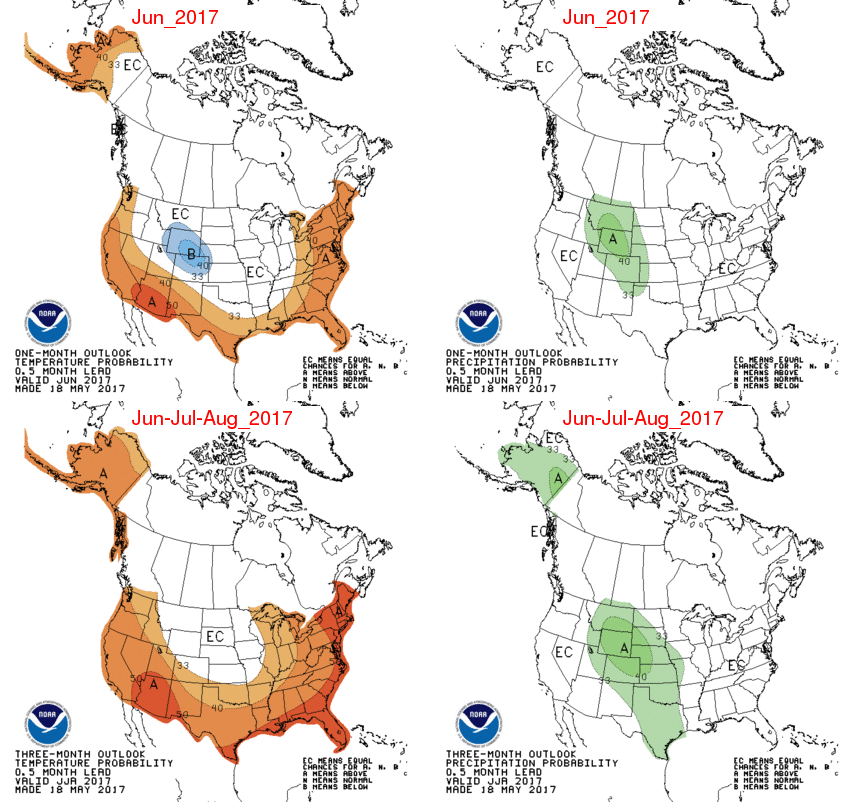Okay, I’m just having a little fun with the headline – every summer in Illinois is warm and humid with a chance of thunderstorms. I wouldn’t have it any other way.
The resort to humor occurred because there was not much exciting to report from the latest NWS monthly and seasonal forecasts released yesterday. For June, Illinois has equal chances of above, below, and near-normal temperature and precipitation. For summer (June-August), Illinois has a slightly increased chance of above-normal temperatures, and equal chances on above, below, and near-normal precipitation. Or to put it another way, there are no strong indications of anything out of the ordinary for this summer.

Summer Temperature and Humidity
Here is how I think summer will likely play out – plenty of humidity, daytime highs near-normal, and nighttime lows above-normal. Right now we are coming off a very wet April and May, resulting in an abundance of soil moisture that will be recycled into the air this summer as higher humidity.
These wetter conditions will also impact summer temperatures. In wetter summers, more of the sun’s energy is used to drive evaporation from the ground and transpiration from the crops and vegetation. That’s less energy being used to heat up the land surface. As a result, we get lower daytime temperatures and more humidity. The reverse is true as well – we usually see 100-degree heat only when the ground is dry (think drought) and more of the sun’s energy goes towards heating up the ground.
However, the higher humidity levels do not allow the temperatures to drop as much at night. You can feel the difference if you have ever camped out West where the dry desert air allows the temperatures to drop quite a bit at night. One forecasting tool for predicting the night-time temperature is to look at the dew-point temperature. If the dewpoint temperature is 60 degrees, you have a chance of getting that cool at night. If your dewpoint temperature is running 75 degrees, it means the nighttime temperature will likely be much warmer.
Okay, why the long explanation? We can actually see this pattern playing out in the historical summer temperatures in Illinois. Our spring and summer precipitation in Illinois has increased by about 15% over the last century. As a result of the wetter conditions, our daytime high temperatures in summer have not increased after the spike in the 1930s (first graph). However, our nighttime temperatures have been increased by almost 2 degrees in the last century (second graph). In addition, 2010, 2016, and 2011 hold the top three positions with the warmest summer nighttime temperatures.


Summer Rainfall
Summer rainfall in Illinois is notoriously hard to predict. Much of our rain in summer comes from thunderstorms driven by local conditions or short-term weather patterns. As a result, some parts of the state can be struggling with drought while other parts are struggling with too much rain. Even in the 2012 drought, we had a few spots in Illinois that were wet.
Having said that, we have seen that summer rainfall has increased historically by about 15% with a lot of variability from one year to the next. The last three summers have been well above normal on rainfall. So that tips the scales towards a wetter summer with a smaller chance of widespread drought at the state level. Your mileage may vary.



I appreciate your frankness about the unpredictability of summer weather, especially with regard to precipitation. As a touring motorcyclist, accurate forecasting (or not) has long been a bit of a hot button for me. Thank you for your insights. I look forward to seeing how this season unfolds.